+995 597 293841
[email protected]
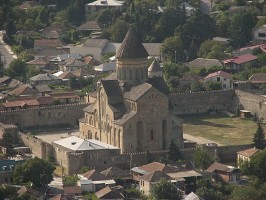 Steeped in history, Georgia’s ancient capital of Mtskheta is a place that no visitor to Georgia should miss, and being only twenty minutes outside Tbilisi, there’s no reason to miss it. Situated at the confluence of the Mtkvari and Aragvi rivers, this UNESCO World Heritage Site has been inhabited since before 1000 BC, and was declared the capital (‘deda-kalaki’ in Georgian) of the early kingdom of Iberia, or Eastern Georgia, in the year 280 BC, under the semi-legendary king Parnavazi. The site, protected by water on two side as well as a ring of mountains, was also located on an ancient trade route, and archaeologists have unearthed evidence of Mtskheta’s status as a major entre-pot. Glass perfume bottles, writing in Greek and Aramaic, pottery, metalwork and jewelry are all found in abundance beneath the ground here, and many examples are on show in the town’s fine Museum. Mtskheta was mentioned in the chronicles of Alexander the Great as one of the strongholds during his campaigns. In the manuscripts of ancient geographer Strabo, Mtskheta was described as a highly developed city with water supply system, markets and stone houses. Mtskheta was also the religious center of the country, with a number of major shrines to Georgia’s pagan pantheon, these would later be replaced by churches when St Nino converted the town – and the country – to Christianity in around 330 AD. Although the capital was moved to the more easily defended Tbilisi in the beginning of the sixth century, Mtskheta continued to be the coronation and burial place of Georgian kings, and the seat of the Patriarch, who is also known as the Bishop of Mtskheta. Today, the lovely old town has a laid back, village feel, especially after the hectic pace of Tbilisi. It is a great place to while away the time in the shadows of ancient castles and churches, and also home to some of the Georgia’s best restaurants – famous for their lobio, or spicy bean stew.
Steeped in history, Georgia’s ancient capital of Mtskheta is a place that no visitor to Georgia should miss, and being only twenty minutes outside Tbilisi, there’s no reason to miss it. Situated at the confluence of the Mtkvari and Aragvi rivers, this UNESCO World Heritage Site has been inhabited since before 1000 BC, and was declared the capital (‘deda-kalaki’ in Georgian) of the early kingdom of Iberia, or Eastern Georgia, in the year 280 BC, under the semi-legendary king Parnavazi. The site, protected by water on two side as well as a ring of mountains, was also located on an ancient trade route, and archaeologists have unearthed evidence of Mtskheta’s status as a major entre-pot. Glass perfume bottles, writing in Greek and Aramaic, pottery, metalwork and jewelry are all found in abundance beneath the ground here, and many examples are on show in the town’s fine Museum. Mtskheta was mentioned in the chronicles of Alexander the Great as one of the strongholds during his campaigns. In the manuscripts of ancient geographer Strabo, Mtskheta was described as a highly developed city with water supply system, markets and stone houses. Mtskheta was also the religious center of the country, with a number of major shrines to Georgia’s pagan pantheon, these would later be replaced by churches when St Nino converted the town – and the country – to Christianity in around 330 AD. Although the capital was moved to the more easily defended Tbilisi in the beginning of the sixth century, Mtskheta continued to be the coronation and burial place of Georgian kings, and the seat of the Patriarch, who is also known as the Bishop of Mtskheta. Today, the lovely old town has a laid back, village feel, especially after the hectic pace of Tbilisi. It is a great place to while away the time in the shadows of ancient castles and churches, and also home to some of the Georgia’s best restaurants – famous for their lobio, or spicy bean stew.
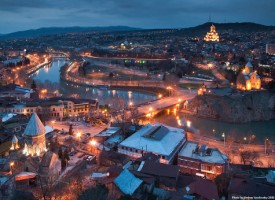 Tbilisi is one of Eastern Europe’s undiscovered gems. At once modern and ancient, European and Asian, it’s the sort of city where many visitors want to settle down permanently. Over the centuries Tbilisi has become synonymous with gracious living and warm welcomes. The name means ‘warm spring’, and comes from the natural hot mineral water springs that dot the centre of the city. It’s said that King Vakhtang Gorgasali decided to make Tbilisi the capital of Georgia back in the 5th century, after a pheasant he was hunting fell into one of these springs and came out perfectly cooked.
Tbilisi is one of Eastern Europe’s undiscovered gems. At once modern and ancient, European and Asian, it’s the sort of city where many visitors want to settle down permanently. Over the centuries Tbilisi has become synonymous with gracious living and warm welcomes. The name means ‘warm spring’, and comes from the natural hot mineral water springs that dot the centre of the city. It’s said that King Vakhtang Gorgasali decided to make Tbilisi the capital of Georgia back in the 5th century, after a pheasant he was hunting fell into one of these springs and came out perfectly cooked.
Thus Tbilisi started its life as an ancient Spa – and still remains so; the superb sulfur baths in the Old Town attracted travellers from Marco Polo to Alexander Dumas. Many great artists like Pushkin, Lermontov, and the composer Tchaikovsky have all sat and composed work under one of the bath’s brick domes.
Tbilisi has been the capital of Georgia for fifteen hundred years, and has been a true urban center for far longer. Here there are layers upon layers of history and the blending of a myriad of cultures, some now long gone. Long a central and vital trade city, Tbilisi has two faces, East and West, and is a remarkable mixture of the two. Many families have lived in Tbilisi for many more than ten generations, more than they can count.
The city has always been at the crossroads of civilizations, a meeting place and a melting pot, and that continues to be true today. Tbilisi is known as a multicultural place, and it is one of the few places in the world where you can find a church, a synagogue and a mosque next door to each other. Today, the city remains very cosmopolitan, with populations of Jews, Armenians, Azeris, Kurds and Russians all living side by side. The city also boasts a thriving expatriate scene, which is getting larger all the time as Tbilisi becomes better known to the outside world.
Tbilisi is also situated in an amazing place, where the massive chains of the Greater and Lesser Caucasus mountains almost touch, along the fast flowing Mtkvari river. Just ten minutes outside the town centre takes you into alpine meadows and virgin forests.
With a great climate and an even better atmosphere, the only problem about coming to Tbilisi is that you might never want to leave.
 At 5,047meters above sea level, Kazbek is only the third highest mountain in Georgia, but with it’s almost perfect snow capped cone, mythological associations and proximity to Tbilisi, it’s certainly the country’s favorite mountain. According to the Greek myth, as punishment for teaching mankind knowledge of fire, the titan Prometheus was chained to a mountainside in the Caucasus for all eternity. According to Georgian versions, it was the icy slopes of Kazbek to which he was chained. At 4000 meters up the side of Kazbek there is a cave that is said to have been the prison of Prometheus, known as Amirani in Georgia. Now called Betlemi (Bethlehem), the cave later served as a hermitage for orthodox monks, and was said to contain many sacred relics, including Abraham’s tent and Christ’s manger.
At 5,047meters above sea level, Kazbek is only the third highest mountain in Georgia, but with it’s almost perfect snow capped cone, mythological associations and proximity to Tbilisi, it’s certainly the country’s favorite mountain. According to the Greek myth, as punishment for teaching mankind knowledge of fire, the titan Prometheus was chained to a mountainside in the Caucasus for all eternity. According to Georgian versions, it was the icy slopes of Kazbek to which he was chained. At 4000 meters up the side of Kazbek there is a cave that is said to have been the prison of Prometheus, known as Amirani in Georgia. Now called Betlemi (Bethlehem), the cave later served as a hermitage for orthodox monks, and was said to contain many sacred relics, including Abraham’s tent and Christ’s manger.
Sometimes called Mkinvartsveri in Georgian, Kazbek is a dormant volcano, and the area around it is very tectonically active. Hot springs, acidic and carbonated lakes surround the mountain, and earth tremors are fairly frequent. Covered with 135 square kilometers of glacier, Kazbek is a great place for ice climbing and mountaineering. Some of the glaciers reach down to 2300 meters, almost to the tree line, and can be reached from Stepantsminda in a day hike. Climbing the summit, however, is a little more complicated. Most ascents take four or five days, and though not especially technically difficult, weather conditions are treacherous, and climbers most be in good physical shape and have excellent local guides. Ascents to the summit are best arranged through tor operators in Tbilisi, or through asking in Stepantsminda.
 Gudauri is the newest skiing resort in Georgia and is perfect for extreme sports. Perched in the heart of the Greater Caucasus, surrounded by a vista of dramatic peaks and breathtaking gorges, and just two hours drive from Tbilisi – Gudauri is spectacular on every level. Set high above the clouds, Gudauri’s southern facing ensures plenty of sunshine and excellent snow conditions until late April.
Gudauri is the newest skiing resort in Georgia and is perfect for extreme sports. Perched in the heart of the Greater Caucasus, surrounded by a vista of dramatic peaks and breathtaking gorges, and just two hours drive from Tbilisi – Gudauri is spectacular on every level. Set high above the clouds, Gudauri’s southern facing ensures plenty of sunshine and excellent snow conditions until late April.
Gudauri’s slopes are all above tree line. They are ideal for free-riders and are generally considered avalanche-safe. This is a perfect place for intermediate to advanced skiiers to test their skills. In Gudauri you truly feel on top of the world. Set at 2000 meters, just below the historic Jvari Pass – the main crossing point of the Greater Caucasus – it offers a wide range of accommodation and summer and winter activities.
In case of accident the ski area is patrolled by experienced ski rescue teams, able to transport any injuries to local, state of the art clinics, where doctors provide first aid. Emergency helicopter transportation is available to the capital’s main hospitals, meaning that your safety is protected throughout your stay.
The resort also boasts some of the best Heli Skiing in the world, at some of the most affordable prices found anywhere. Throughout the season skiers and snowboarders can choose from seven peaks all just minutes away and enjoy lengthy runs on virgin snow.
In summer the resort is surrounded by a selection of fabulous treks and horse trails, taking in some of Europe’s most unspoiled alpine scenery, stunning medieval churches and castles, and world famous bird watching. The excellent, modern and well-appointed hotels offer all the facilities needed for international conferences and workshops – in an inspiring setting.
Sitting astride the newly refurbished and historic Georgian Military Highway there can be no better launch pad than Gudauri for explorations of the Greater Caucasus, 12 months of the year.
 Bakuriani is Georgia’s year-round mountain playground and was the coutry’s first ski resort. The area became famous in the 19th century when the Romanov family developed the it as a game reserve and mountain retreat. They even hired Gustav Eiffel to design a bridge for a narrow-gauge railway up to its verdant pastures. There the Russian aristocracy enjoyed abundant coniferous forests, crystal clear air and breath-taking views. Meeting Olympic standards, Bakuriani was the training ground of champions in the Soviet era. Now it has become Georgia’s beloved family destination, a superb venue for small children to take their first steps onto the slopes, and popular among the snowboard generation. On clear days much of the Greater Caucasus is visible against the horizon all the way to Mt. Elbruz – the highest mountain in Europe. The village of Bakuriani sits in a wide volcanic crater at an altitude of 1,650m, surrounded by virgin spruce forest. It is connected by narrow-guage railroad to the valley spa town of Borjomi, the summer playground of the Czars.
Bakuriani is Georgia’s year-round mountain playground and was the coutry’s first ski resort. The area became famous in the 19th century when the Romanov family developed the it as a game reserve and mountain retreat. They even hired Gustav Eiffel to design a bridge for a narrow-gauge railway up to its verdant pastures. There the Russian aristocracy enjoyed abundant coniferous forests, crystal clear air and breath-taking views. Meeting Olympic standards, Bakuriani was the training ground of champions in the Soviet era. Now it has become Georgia’s beloved family destination, a superb venue for small children to take their first steps onto the slopes, and popular among the snowboard generation. On clear days much of the Greater Caucasus is visible against the horizon all the way to Mt. Elbruz – the highest mountain in Europe. The village of Bakuriani sits in a wide volcanic crater at an altitude of 1,650m, surrounded by virgin spruce forest. It is connected by narrow-guage railroad to the valley spa town of Borjomi, the summer playground of the Czars.
Featuring a wide array of newly built hotels, guest houses, and chalets in tasteful settings, accommodation is both plentiful and affordable in Bakuriani. Most prices include lavish breakfast and dinner buffets.
Bakuriani boasts a unique climate, due to the fact the resort lies in a subtropical zone but at a high altitude. Summer is temperate and relatively cool (the average temperature is 20 degrees) and the winter is very wet and snowy but relatively mild. In the spring it is common to be able to ski in the sunshine without jackets. The average depth of snow is 60 cm, but the sun shines over the area for more than 2,000 hours a year.
The skiing season lasts from December till at late as mid April, but the fabulous nature and pictruresque scenery are year-round. The town is 190 kilometers from Tbilisi, minibusses depart several times a day from Didube bus station, the journey takes two and a half horurs.
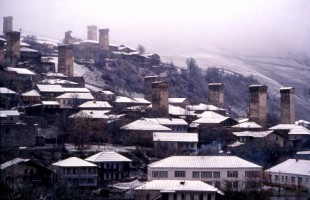 Most visitors to Svaneti will want to see Mestia and Ushguli, the highest village in Europe. Mestia is the staging post for most trips to Svaneti, with a range of hotels and guesthouses, as well as local travel services; Mestia is a convenient base for exploring the area. From the centre of the town it is possible to hike up to the glaciers at the foot of mount Ushba, or take horses up to pristine alpine meadows. The town is increasingly becoming a year-round destination. Mestia also contains the amazing History and Ethnography Museum, which houses a unique collection of icons, manuscripts and metalwork, testament to Svaneti’s place as a sanctuary for the treasures of Georgia. Also worth visiting is the Margiani Family Dwelling Complex, which recreates what life was like in Svaneti for hundreds of years. The complex consists of a typical Svan house and watchtower. The tower, angled towards the slope of the nearby mountain so as to withstand avalanches and landslides, and the house with its dining room/cow shed, show just how dangerous and hard life was here.
Most visitors to Svaneti will want to see Mestia and Ushguli, the highest village in Europe. Mestia is the staging post for most trips to Svaneti, with a range of hotels and guesthouses, as well as local travel services; Mestia is a convenient base for exploring the area. From the centre of the town it is possible to hike up to the glaciers at the foot of mount Ushba, or take horses up to pristine alpine meadows. The town is increasingly becoming a year-round destination. Mestia also contains the amazing History and Ethnography Museum, which houses a unique collection of icons, manuscripts and metalwork, testament to Svaneti’s place as a sanctuary for the treasures of Georgia. Also worth visiting is the Margiani Family Dwelling Complex, which recreates what life was like in Svaneti for hundreds of years. The complex consists of a typical Svan house and watchtower. The tower, angled towards the slope of the nearby mountain so as to withstand avalanches and landslides, and the house with its dining room/cow shed, show just how dangerous and hard life was here.
At 2200 meters above sea level, Ushguli is the highest permanently inhabited village in Europe, and a UNESCO World Heritage Site. The 45-kilometer road from Mestia is stunningly beautiful, with breathtaking views of Ushba and Shkhara, as well as the lovely villages of Kala and Ipari en route. Ushguli itself is a collection of four smaller villages, all of them made up of four or five story towers. There is superb hiking and climbing in the area, as well as possibilities for horse riding and mountain biking.
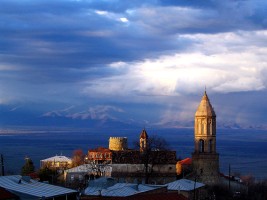 Nestled atop a vine-covered hillside in the heart of Georgia’s wine country, the walled city of Sighnaghi is a hidden treasure known for its charm, beauty and romance. Steeped in history, and now meticulously restored to its former glory, Sighnaghi offers the elegance of the eighteenth century, as well as the comfort and luxury your would expect from any top class holiday destination. Now boasting a host of restaurants serving both Georgian and international cuisine, top class museums and a broad range of hotels and guesthouses, Sighnaghi is a must see destination for all those visiting Georgia. This lovely hilltop town is famous for its stunning landscapes, winding streets, hilltop gardens and beautiful skyline. A walk down Sighnaghi’s cobbled streets transports the visitor to a world of ornately hand carved balconies, fine food and an ancient tradition of hospitality. Commanding breathtaking views of the snow-capped Caucasus mountains, and with a long tradition of craftsmanship and culture, it is impossible to resist Sighnaghi’s intoxicating charm. Renowned for its hand-woven carpets, woodworking crafts and hauntingly beautiful music, Sighnaghi is now becoming a artistic centre in its own right. The recently refurbished Museum hosted the first ever exhibition of Picasso’s works in Georgia, and there is a music and cultural festival every September, which attracts performers from around the world. Visitors to the city find a rich vein of culture running from ancient times through to the present day. Verdant gardens stretch out beneath the town’s defensive wall, as imposing today as it was when it was built centuries ago. Polyphonic music from world-renowned choirs echoes around ancient churches, and traditionally produced wine flows from the vineyards that surround the town. The name Sighnaghi comes from the Turkish word for sanctuary, and within the ancient walls of this most romantic of towns you will see why the name has stuck
Nestled atop a vine-covered hillside in the heart of Georgia’s wine country, the walled city of Sighnaghi is a hidden treasure known for its charm, beauty and romance. Steeped in history, and now meticulously restored to its former glory, Sighnaghi offers the elegance of the eighteenth century, as well as the comfort and luxury your would expect from any top class holiday destination. Now boasting a host of restaurants serving both Georgian and international cuisine, top class museums and a broad range of hotels and guesthouses, Sighnaghi is a must see destination for all those visiting Georgia. This lovely hilltop town is famous for its stunning landscapes, winding streets, hilltop gardens and beautiful skyline. A walk down Sighnaghi’s cobbled streets transports the visitor to a world of ornately hand carved balconies, fine food and an ancient tradition of hospitality. Commanding breathtaking views of the snow-capped Caucasus mountains, and with a long tradition of craftsmanship and culture, it is impossible to resist Sighnaghi’s intoxicating charm. Renowned for its hand-woven carpets, woodworking crafts and hauntingly beautiful music, Sighnaghi is now becoming a artistic centre in its own right. The recently refurbished Museum hosted the first ever exhibition of Picasso’s works in Georgia, and there is a music and cultural festival every September, which attracts performers from around the world. Visitors to the city find a rich vein of culture running from ancient times through to the present day. Verdant gardens stretch out beneath the town’s defensive wall, as imposing today as it was when it was built centuries ago. Polyphonic music from world-renowned choirs echoes around ancient churches, and traditionally produced wine flows from the vineyards that surround the town. The name Sighnaghi comes from the Turkish word for sanctuary, and within the ancient walls of this most romantic of towns you will see why the name has stuck
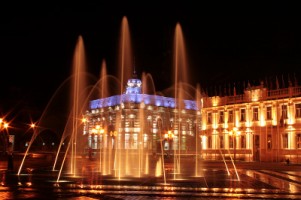 Batumi is a city which visitors can’t help but fall in love with. Its unique blend of subtropical coastline framed by rich green mountains and topped with legendary nightlife. The health giving qualities of this combination of sea and mountain air is renowned, and perhaps one reason why Georgia can boast twice the world average of centenarians. The fields around the city are mostly tea and citrus plantations, spotted with ancient ruins.
Batumi is a city which visitors can’t help but fall in love with. Its unique blend of subtropical coastline framed by rich green mountains and topped with legendary nightlife. The health giving qualities of this combination of sea and mountain air is renowned, and perhaps one reason why Georgia can boast twice the world average of centenarians. The fields around the city are mostly tea and citrus plantations, spotted with ancient ruins.
Batumi is Georgia’s number one beach resort. The open waters of the Black Sea connect Batumi with Russian, Turkish and European ports – as does its new international airport. The nearby beaches at Kobuleti and Sarpi are well resourced with hotels and restaurants.
The architecture of Batumi is particularly refined, the city being constructed at the height of Art Nouveau when it stood as the primary gateway from Western Europe into Georgia. Its streets are dotted with architectural wonders, including a mosque, synagogue and lovely churches. More recently, Batumi’s economic boom has seen investors flood in, and Batumi is being transformed into a vibrant, modern resort. Tope end hotels like Sheraton and Hyatt have opened up shop, and the clubs, bars and restaurants in Batumi are the best on the Black sea.
Throughout Batumi you’ll also enjoy many entertainment possibilities, as well as sport competitions like Polo, tennis and Georgian wrestling. The city is known for hosting singing and dancing performances, and a critically acclaimed annual Jazz festival that attracts stars from all over the world.
 Unspoiled, unknown and unbelievably beautiful, Tusheti is one of those places that has to be seen to be believed. Located in northeastern Georgia, on the northern slopes of the Greater Caucasus mountains, Tusheti borders Chechnya and Dagestan in Russia, Khevsureti in the west and Kakheti in the south. One of the most ecologically unspoiled regions in the Caucasus, the region’s unchanged ancient pastoral culture and fabulous mountain villages are some of the greatest attractions of the entire Caucasus region. The severity and beauty of Tusheti Mountains, the wild nature, and the imposing architectural monuments from ages past closely intertwine to leave no visitor disappointed. Mta-Tusheti, or mountainous Tusheti, was included in the Tentative World Heritage list in 2007.
Unspoiled, unknown and unbelievably beautiful, Tusheti is one of those places that has to be seen to be believed. Located in northeastern Georgia, on the northern slopes of the Greater Caucasus mountains, Tusheti borders Chechnya and Dagestan in Russia, Khevsureti in the west and Kakheti in the south. One of the most ecologically unspoiled regions in the Caucasus, the region’s unchanged ancient pastoral culture and fabulous mountain villages are some of the greatest attractions of the entire Caucasus region. The severity and beauty of Tusheti Mountains, the wild nature, and the imposing architectural monuments from ages past closely intertwine to leave no visitor disappointed. Mta-Tusheti, or mountainous Tusheti, was included in the Tentative World Heritage list in 2007.
Underlining its remoteness, the road to Tusheti is open only for three or four months a year, from May-July till mid September-November. The people here have a transhumant existence, coming up into the summer pastures with their sheep in the summer, and retreating to the lowland in winter, when just a tiny handful of people live in the mountains. The area is thought to have long been inhabited by the Tush, a subgroup of Georgians, which themselves divide into two groups- the Chagma-Tush who speak the local Georgian dialect and the Tsova-Tush, known as Bats or Batsbi, who speak a language related to Chechen. King Levan of Kakheti (1520–1574) apparently granted the Bats official ownership of the lands in the Alvani Valley in exchange for their military service. Bats-speaking inhabitants of Tusheti are known to the local Georgians as the Tsova-Tushs, they have a high degree of assimilation and are typically bilingual, using both Georgian and their own Bats languages. The Tush are sheep herders, (they are famous for their sheep cheese, guda, which was originally made inside a tied up sheepskin bag). As sheep herders from time immemorial, the woolen work of Tusheti is highly developed. Knits, weaves and pressed felt are all common in Tusheti, and all bear the characteristic marks of the local style. Knitted Tusheti socks and gloves are popular gifts in Georgia, as are the pressed felt goods made by the Tush, including rugs, shawls and hats. Woven goods include Tusheti carpets, often brightly colored and decorated in unique local ornaments, or the thick woolen Nabadi cloak, the only thing that can keep out the chills of the high mountains. Although they consider themselves Christian, much of their religion is made up of pagan elements, with ritual animal sacrifice, shrine-deities an special ritual practitioners
 Sheltered by the massive peaks of the greater Caucasus, hidden away from the outside world is the extraordinary land of the Khevsurs – Khevsureti. Nowhere else in Europe is there a place that feels so mysterious, unique and magical, a place where ancient pagan traditions survive, and medieval fortress villages guard the secrets of the valleys. Only accessible by road for seven months a year, Khevsureti moves at its own pace, and it likes it just fine that way. Until the 1930s people here wore chainmail amour and carried swords and shields, the soviet Union did much to try to destroy the ancient way of life, but rituals, songs and crafts are still preserved by the people of this proud, independent land.
Sheltered by the massive peaks of the greater Caucasus, hidden away from the outside world is the extraordinary land of the Khevsurs – Khevsureti. Nowhere else in Europe is there a place that feels so mysterious, unique and magical, a place where ancient pagan traditions survive, and medieval fortress villages guard the secrets of the valleys. Only accessible by road for seven months a year, Khevsureti moves at its own pace, and it likes it just fine that way. Until the 1930s people here wore chainmail amour and carried swords and shields, the soviet Union did much to try to destroy the ancient way of life, but rituals, songs and crafts are still preserved by the people of this proud, independent land.
The Khevsurs never submitted themselves to any feudal lord, taking decisions independently, steered by community leaders called khevisberis, who also acted as priests for the local shrine, each of which had its own pagan deity. Animal sacrifice is still common here, but some of the regions other traditions have died out. Among the more bizarre practices that used to practiced here are the seclusion of menstruating women in a special hut (where they also had to give birth), and the officially sanctioned erotic relationships between teenage boys and girls of the same clan that could never lead to marriage. During times of plague, ill people and those too old to hope to survive would sacrifice themselves for the good of the community by climbing into shrines located on the outskirts of town. These death houses, full of human bones, can still be seen outside many Khevsur villages.
Blood feuds were common in this remote land, where life was always hard and family honor paramount. Constant war with the Muslim peoples of the North Caucasus resulted in the extraordinary architecture seen here today, with many villages actually designed as fortresses, with family homes doubling as defensive structures.
